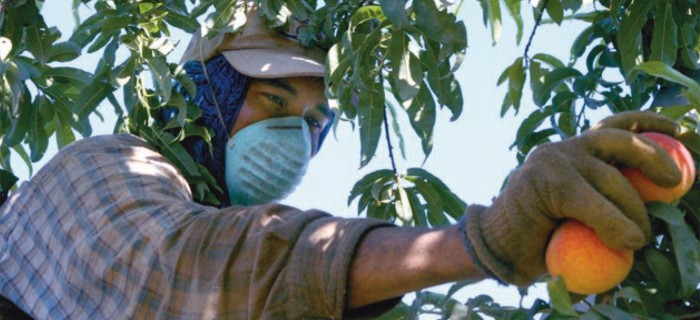Food Workers Food Justice: Linking Food, Labor and Immigrant Rights
Food First Backgrounder, Summer 2010, Vol. 16, No. 2
A fair deal for food workers is an essential part of the foundation of an equitable, sustainable food system.
The food movement in the US is growing stronger, but too often the people who work in our food system are overlooked. Some 17% of all U.S. jobs are in the food sector.i Many of these jobs are carried out by undocumented immigrant workers. Consequently, food workers are the lowest paid and most under-protected workers in the nation. Low wages and substandard working conditions subsidize the enormous profits of the food industry and puts the triple burden of poverty, labor abuse and food insecurity on those most vulnerable. The movement for food justice cannot thrive in a system where food workers are criminalized, exploited, and going hungry.
Labor in the Corporate Food System
In 2009, the U.S. Bureau of Labor Statistics listed food preparation and serving-related occupations as the lowest paid of all occupational categories ($8.59 median wage), followed by farming, fishing and forestry ($9.34 median wage). Twenty-five percent of grocery workers experience minimum wage violations. On-the-job injuries are common. According to Oxfam, in 2004 farm-workers suffered the highest rates of toxic chemical injuries, with an estimated 300,000 pesticide poisonings yearly. A decline in union representation—from 35% to 12% since World War II—parallels the spread of poor labor conditions, dependence on undocumented labor and corporate concentration.iv Aggressive anti-union campaigns and recruitment of temporary or foreign workers hinder organizing efforts and keep labor costs painfully low. Real wages for meatpacking workers fell from $20/hr in 1977 to $10.50/hr in 2001, while consolidation of the beef packing industry increased drastically. By 1999 the top four firms controlled 80% of the market—more than doubling in two decades. Meanwhile, rates of undocumented workers have risen to an estimated 20 to 50% of the workforce. Sadly, this kind of exploitation is not unique to meatpacking, but also common in the field, the store, and the restaurant.
In The Field
The women and men who harvest, pack, process and serve our food can’t afford to feed their own families healthy food. Research conducted by the California Institute for Rural Studies (CIRS) (2007) in Fresno County, CA—the state’s breadbasket—found that 45% of farm workers surveyed were food insecure and 48% were on food stamps—more than double the national average. Since job opportunities and wage rates are key determinants of food security, it is safe to assume that food workers are among the most insecure. Their dependence on cheap, processed food as a source of needed calories results in high rates of obesity and diet-related illnesses. Another survey done by the CIRS in 1999 of farm workers in six regions throughout California found that 81% of males and 76% of females were overweight and 28% and 37% were obese, respectively.
In The Store
Stay in the loop with Food First!
Get our independent analysis, research, and other publications you care about to your inbox for free!
Sign up today!In food retail, permanent, economically secure jobs are being replaced with temporary contract work. Labor contractors provide large firms with short-term workers for low-wage, low-skill jobs. Why? All personnel, insurance and labor issues relating to those employees automatically become the responsibility of the contract agent. In this way, big corporations can wash their hands of responsibility for inhumane or unfair job conditions—even as they profit from exploited labor. As Safeway spokeswoman, Susan Houghton stated when asked about the unfair and unhealthy labor conditions of Safeway’s janitors, “We just contract with these companies to provide services… This is something you need to talk to the vendors about.” Workers bouncing from job to job are less likely to organize and unionize than workers with job security and legal residency. This undermines labor rights and long-term economic security for all workers, encouraging a “race to the bottom” in the labor market.
In The Restaurant
Jobs in the restaurant business have grown significantly faster than jobs in other sectors in the past decade, but the benefits of growth do not necessarily filter down to workers. At $2.13 an hour, the federal minimum wage for tipped workers has not changed in 19 years, in fact it fell 37% in real terms since it was established in 1991. According to the National Employment Law Project, tipped workers have twice the poverty rate of other workers.


 Help Food First to continue growing an informed, transformative, and flourishing food movement.
Help Food First to continue growing an informed, transformative, and flourishing food movement.




